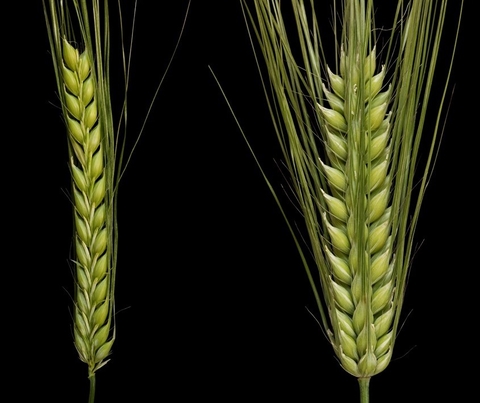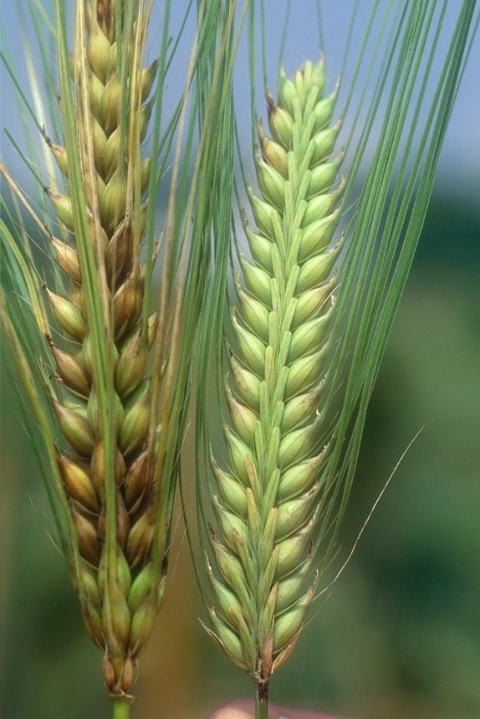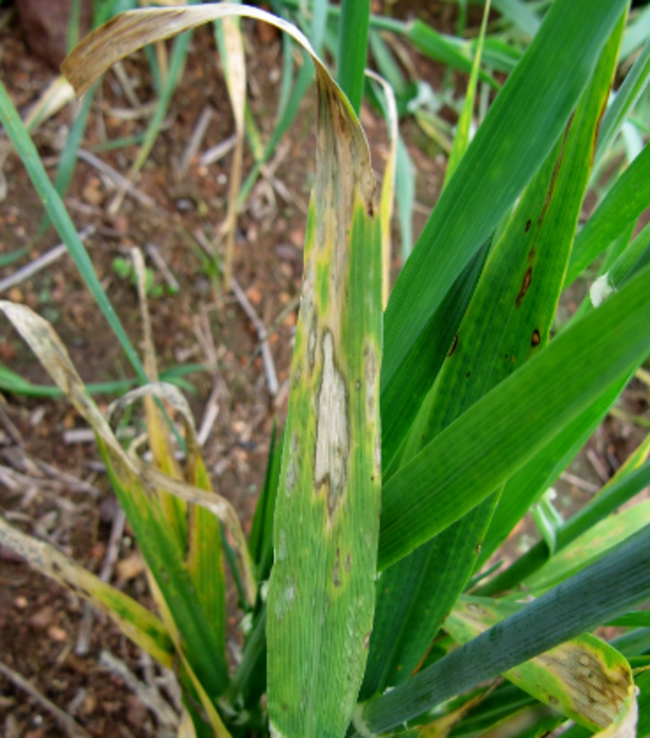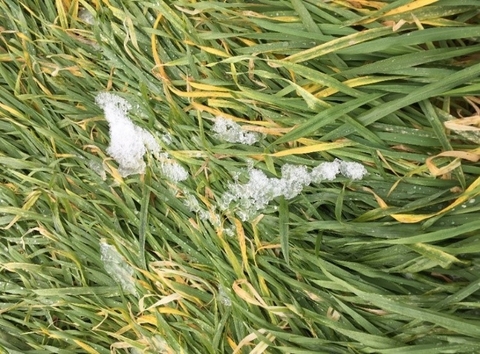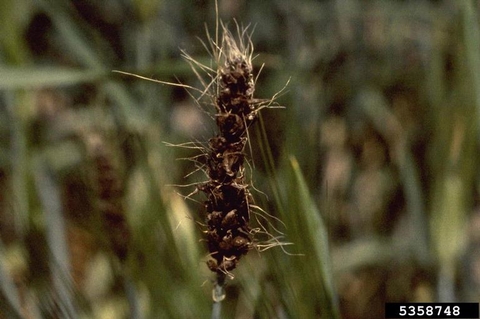History of barley production
Barley was one of the first domesticated crops and is now cultivated throughout the world. In Minnesota, barley has been an important spring-sown crop for more than 130 years, reaching a peak acreage over 1.2 million acres in 1988.
These days, the crop is used primarily for malt and feed, along with various food products. Barley used for malting is an important value-added commodity for producers. According to the Minnesota Barley Growers Association, high quality barley grown to malting specifications can command premium prices over feed-grade barley.
In 2018, over 65% of barley produced in the United States was used for malt production for brewing. Over the past 30 years, barley acreage in the state has been on a steady decline. This was due to various market forces, competition with row crops such as corn and soybeans, and the fungal disease Fusarium Head Blight (FHB) or “scab.” Despite this downward trend, there is increased optimism for a recovery of barley acreage:
- The upsurge of craft breweries is creating a demand for locally produced malting barley (Figure 1).
- Increasing ecological pressures on the predominant corn/soybean cropping system threaten its sustainability.
- Changes in cropping systems toward autumn-sown crops could evolve to prominently include winter barley as the main grain crop.
Unique opportunities for winter barley
In Minnesota, all of the barley is sown in the spring (April-May) and is referred to as spring barley. Winter barley, sown in autumn, has not been cultivated in the state because varieties do not have sufficient winter-hardiness to reliably survive.
University of Minnesota barley breeding program
The barley improvement program at the University of Minnesota (UMN) has been in existence for over a century and has developed a number of popular, widely adapted spring six-rowed malting barley varieties.
Historically, six-rowed barley has been the predominant type grown in Minnesota. However, a very recent preference change now has most brewers favoring two-rowed varieties for brewing. Brewers prefer malts from two-rowed types, because the kernels are more uniform in size and can be crushed more effectively than the smaller laterals of six-rowed types. Two-rowed barley also produces more barrels of beer.
With the growing interest in winter barley and demand for two-rowed barley varieties, the established UMN breeding program is shifting its focus to develop two-rowed winter/facultative and spring type varieties (Figure 2).
Barley type definitions
Vernalization requirements
True winter barley varieties require vernalization [i.e. cold period] to flower. Winter barleys are sown in the autumn.
Facultative barley varieties do not require vernalization to flower and are usually sown in the autumn but can also be spring-seeded.
Row types (Figure 3)
Two-rowed barley - Most brewers favor two-rowed barley because they generally have:
- plumper kernels,
- higher malt extract,
- lower DON, and
- lower protein.
Six-rowed barley- Advantages of six-rowed barley include:
- higher amylase,
- higher yield in the Midwest, and
- better leaf disease resistance.
Several winter/facultative two-rowed barley varieties have been released in the United States; however, they generally exhibit limited winter hardiness and are not ideal varieties for Minnesota. Consequently, increasing winter hardiness is the main emphasis in the University of Minnesota’s winter/facultative breeding program.
Target environment
Southern Minnesota is the target environment for this winter/facultative barley, where the average annual extreme minimum temperatures do not drop below -25oF (USDA Plant Hardiness Zone 4B). Winter climate in this area is not as harsh as northern Minnesota and the possibility of double cropping may exist.
If the breeding program can develop varieties with sufficient and reliable winter hardiness, these lines can be tested in the central and northern parts of the state for their adaptation. Despite steady progress in barley breeding, there is still a great need for improved barley varieties that provide the raw material for a wide array of end-use products, especially for malt. The complexity of both malting quality and winter hardiness traits makes simultaneous improvement a challenge for barley breeding.
Autumn-sown winter/facultative barley varieties have many advantages over the traditional spring-sown barley that is currently grown in the Upper Midwest and other regions of the country:
- Higher yields -
In many regions, winter/facultative barley often produces higher yields than spring barley. - Disease escape potential -
Because autumn-sown winter barley matures earlier, it may help the crop escape from common “summer” diseases such as stem rust (Puccinia graminis f. sp. tritici), and FHB (caused primarily by Fusarium graminarum), depending on environmental conditions. FHB is particularly devastating because it can not only lower yields, but also severely reduce grain quality through mycotoxin contamination by the causal fungus. - Ecological services -
Autumn-sown winter barley also provides various ecological services. It has a significant advantage in weed suppression and can typically be grown with no herbicide applications. When compared with winter wheat, winter barley utilizes nitrogen more effectively, enabling the crop to produce higher yields with fewer fertilizer inputs. - Avoid wet spring planting delays -
Autumn-sown winter barley can eliminate the risk of planting in Minnesota’s increasingly common wet springs and take advantage of the extended cooler spring and fall growing conditions that favor barley growth and development. - Ease labor demands -
Sowing winter barley in the autumn and harvesting in early summer allows growers to spread out their labor demands and utilize farm machinery more efficiently.
Challenges
Autumn-sown winter barley is not without its challenges:
- Lack of winter-hardiness -
A lack of sufficient winter hardiness to reliably survive the harsh Minnesota winters is a major challenge. - Other diseases -
Not commonly observed in spring-sown barley could become important in autumn-sown winter barley (see disease section below).
Since 2011, the craft beer industry has experienced greater than a five-fold increase of expansion in Minnesota. A bill passed in the Minnesota State Legislature in 2011 allows craft breweries to make and sell their wares on site.
Minnesota is an ideal location for growing barley because of its productive soils and centralized geography to major malting facilities. The state is home to two large malting companies:
- Rahr Malting Company in Shakopee is the largest malting plant in the world with a capacity of 460,000 MT.
- Busch Agricultural Resources Inc. (BARI) is located in Moorhead, Minnesota.
In addition to these large malting companies, the malting volume of smaller craft malt houses is growing in the state. In 2017, Minnesota boasted over 150 craft breweries.
Malting companies would like to source locally produced barley to reduce the high cost of shipping grain from the west. Moreover, many craft brewers are interested in environmental sustainability and are seeking to source all locally-produced ingredients.
Introducing winter barley to the dominant corn-soybean cropping system may contribute both economic and environmental benefits to the grower, farm, and the greater landscape. Cropland accounts for 51% of the total land area in Minnesota as of 2018 and agricultural land management choices can have major effects on water quality.
Economic advantage to malting barley
As mentioned above, barley used for malting is an important value-added commodity for producers. High quality barley grown to malting specifications can receive a substantial premium over feed-grade barley. If barley does not meet the standards for malting, it may be classified as feed grade, resulting in a substantial reduction in price. In addition, establishment costs for growing winter/facultative barley will also vary from farm to farm, affecting the bottom line.
Malting grade standards
To achieve malting grade, barley must meet minimum quality requirements.These include limits on grain protein content and being within acceptable limits of contamination from fungal diseases.
- Protein content must be lower than or equal to 12% for general malting purposes in two-rowed barley grains and further limited to 10.5% maximum for the craft brewery standards.
- Kernel plumpness is also an important factor forin the considerations of malting barley specifications. For two-rowed malting barley, kernels must have at least 90% plumpness (i.e. retained on a 6/64” slotted sieve) according to the American Malting Barley Association.
- Mycotoxin limits - The fungus that causes FHB produces a toxin (deoxynivalenol (DON) or vomitoxin) that can contaminate the grain. A limit of 1 ppm of DON must be met for malting barley used in all finished products that may be consumed by humans (Burrows, 2012).
Double cropping winter barley and soybean in the same year may also be a possibility. In southern Minnesota, the growing season may be long enough to facilitate a double-cropping system. This would enable winter barley to share some of the large acreage traditionally planted to soybean.
The extensive summer annual cropping systems actively grow for only a few months in Minnesota, leaving fields fallow for much of the year. Without crops covering the land, fallow ground is vulnerable to wind and water erosion, as well as nutrient runoff. Nutrient runoff can build-up in lakes, streams and rivers and negatively affect water quality. A double cropping system could provide cover for a much longer period of time (Figure 4).
Although double cropping small grains and soybean is commonly practiced in the southeastern part of the country, the growing environment in the Upper Midwest is markedly different. Nonetheless, exploring whether double cropping winter barley in combination with a second, short-season , summer annual like soybeans, dry beans, or peas is possible is worth exploring.
Cultural management considerations
The first step to introduce winter barley into Minnesota’s cropping systems is to allow it to survive Minnesota’s winter. Apart from the development of winter hardy winter barley varieties, cultural practices such as varietal selection, planting date, seeding density, and fertility management can greatly influence winter survival.
Fall planting date trials
In winter wheat, planting date can greatly influence winter survival and yield. To evaluate the effect of planting date on winter survival of winter barley in Minnesota, a planting date experiment was conducted:
- Time of study - The study was conducted from 2009 to 2018.
- Locations - Five locations were selected in Minnesota - Two in the northern half of the state and 3 in the southern half (Figure 5). The locations represent two diverse regions for testing the viability and agronomic performance of winter barley. The area between Moorhead and Crookston exemplifies the current spring barley production zone in Minnesota.
- Varieties - Three varieties with varying levels of winter hardiness were selected (Table 1).
- Planting dates - Winter barley was planted at four dates in two-week intervals from early-September to mid-October.
Table 1. Description of winter barley varieties selected for the winter barley planting date study from 2015 - 2017.
| Variety | Origin | Year of release | Growth habit/row type | End-use purpose | Winter hardiness rating |
|---|---|---|---|---|---|
| Charles | Aberdeen, ID | 2005 | Winter two-row | Malt | Low - medium |
| Maja | Corvallis, OR | 2006 | Facultative six-row | Feed | Low - medium |
| McGregor | Wisconsin | unknown | Winter six-row | Feed | Medium - high |
Winter survival results
Overall, the three locations in southern MN (St. Paul, Rosemount, and Lamberton) experienced much greater survival than the two locations in northern MN (Crookston and Moorhead). When more than 50% of the initial stand survived the winter, the varieties in the trial developed a sufficiently adequate canopy to suppress weeds and warranted to be harvested for grain. The variety McGregor met the 50% winter survival threshold to viable grain yield more than half of all of the site-years in southern to central MN (Table 2).
Table 2. Proportion of years the variety McGregor met the winter survival threshold of 50% and above across five locations.
| Location | Years of survival/total site-years |
|---|---|
| Northern MN | |
| Crookston | 1 of 4 |
| Moorhead | 1 of 3 |
| Southern MN | |
| St. Paul | 3 of 5 |
| Lamberton | 2 of 3 |
| Rosemount | 1 of 2 |
Optimal planting window
The 50% survival threshold is associated with an accumulation of 500-1400 Growing Degree Days (GDDs) between planting and freeze-up in the fall. However, this does not apply to winter barley tested in northern Minnesota, where less snow retention and colder temperatures increase winter injury risk.
Optimal fall planting windows for Minnesota are listed in Table 3. These ranges factor in both the optimum fall GDD accumulations and later planting dates to avoid barley yellow dwarf virus (BYDV) infections.
Table 3. Estimated planting window for winter/facultative barley in various agricultural regions across Minnesota. The optimal planting dates are later to avoid heavy insect populations and movement in the fall.
| Location | Optimal planting date range |
|---|---|
| Rochester region | 9/11 - 9/27 |
| Waseca region | 9/11 - 9/26 |
| Lamberton region | 9/11 - 9/25 |
| St. Cloud region | 9/11 - 9/25 |
| Morris region | 9/11 - 9/22 |
| Crookston region | 9/1 - 9/17 |
The currently available winter barley varieties that are adapted to the Midwest are only marginally winter hardy for southern Minnesota and not winter hardy enough for Northern Minnesota.
As new winter barley varieties with better winter hardiness are developed by the University of Minnesota and successful winter survival becomes routine, other best management practices, including fertility management, disease and pest management will become more important. Management of powdery mildew and barley yellow dwarf virus will likely be key to successfully introduce winter barley as a winter annual in the current corn/soybean cropping system. Some of those management issues and questions are introduced and detailed below.
Nitrogen input requirements are relatively low for barley. Thus, the crop should be grown under moderate nitrogen fertility conditions, because high fertility will impact malting grade in the following ways:
- Reduced kernel plumpness.
- Increased grain protein content.
- Increased risk of lodging.
Target grain protein concentrations between 11.5% and 13% when determining the appropriate nitrogen fertility levels. Fertilizer recommendations for spring barley production in Minnesota could be relevant for winter barley production. However, additional research is needed to validate whether or not these recommendations are appropriate for winter barley.
Further research to examine other agronomic management practices such as planting density, row spacing, and fertility management will be crucial to the successful production of winter barley. While breeders will continue to develop winter/facultative barley varieties that can consistently survive and thrive under winter conditions in Minnesota, producers should do everything they can to plant at the proper time, depth, and in better drained fields to increase the chances of winter survival.
Pest management
Compared to winter wheat, winter/facultative barley may require fewer crop protection inputs, such as fungicide and insecticide applications. In this respect, it is a lower input crop, helping to reduce overall expenditures and easing farm cash-flow.
Disease concerns
Diseases caused by a variety of pathogens are just one factor that may reduce yield and quality of the winter barley crop. Making an accurate diagnosis is important so you can effectively manage any emerging the diseases.
The most economically significant disease in Minnesota is Fusarium head blight (FHB), also known as scab. FHB can cause yield losses by reducing kernel development. The fungus causing FHB (primarily Fusarium graminearum) also produces a mycotoxin (DON), which is harmful to humans and animals. For this reason, the threshold for DON content in malting barley is very low (< 1 ppm).
Disease development
Barley spikes become prone to infection by F. graminearum as soon as they emerge from the flag leaf sheath. Infection is favored by prolonged wet weather and high humidity.
The typical early symptoms of FHB on barley include tan to dark brown lesions at the base of the kernels (Figure 6). These symptoms can spread across the entire kernel within a few days under warm, moist conditions. Early infections result in complete sterility of florets, whereas late infections may only reduce yield slightly.
Autumn-sown winter barley typically heads early (early June) and may avoid weather conditions that are most favorable for FHB infection and development.
Growers can use the national Fusarium Risk Assessment Map or state based models for Minnesota and North Dakota to check for the risks of FHB infection throughout the growing season.
Management
Plant resistant varieties
Consider planting moderately resistant varieties, when available. For example, two winter two-rowed malting barley cultivars, Endeavor and Calypso, displayed superior resistance to DON accumulation in North Carolina. However, these particular varieties are not adapted for our climate.
Fungicide applications
Consider applying fungicide if there is risk for FHB development. Researchers in North Carolina found that the fungicides prothioconazole + tebuconazole (Prosaro®) applied six days after full spike emergence significantly reduced FHB severity in winter barley compared to no fungicide or fungicide applied at spike emergence.
Several foliar fungal diseases have been found in winter barley trials in Minnesota. As winter barley production increases in the state, it is possible that these diseases will become more prevalent. These include powdery mildew, leaf rust, and leaf scald. Barley yellow dwarf is caused by a virus and is discussed in a separate section below.
Powdery mildew (Blumeria graminis f. sp. hordei (previous epithet Erysiphe graminis f. sp. hordei)
Powdery mildew is caused by a fungus that overwinters on stubble and straw or volunteer barley and certain wild grasses. Heavy, succulent plant growth favors mildew development.
The most common signs on barley include powdery, gray-white, or buff-color spore masses on the leaves, leaf sheaths, and spikes (Figure 7). Yellowing, browning, and ultimately leaf death follows heavy powdery mildew infection.
The best management strategy for mildew control is to plant resistant varieties. Although some effective fungicides are available for barley, they are an added input cost for growers. Another important management strategy is to reduce inoculum survival from one season to the next by
- Rotating crops.
- Eliminating crop residue.
- Controlling volunteer barley and weed hosts.
Leaf rust (Puccinia hordei)
Leaf rust is an important and widely distributed disease found on barley. The most common signs include orange-brown pustules containing thousands of urediniospores (Figure 8). These form primarily on leaf surfaces and are often surrounded by a yellow (chlorotic) halo.
Leaf rust is caused by a fungus that develops rapidly between 59°F and 72°F when moisture is not limiting. This disease can be controlled by foliar fungicides, particularly those with systemic action. For most situations, using resistant varieties is the best and most useful control measure.
Leaf scald (Rhynchosporium commune)
Leaf scald is a common disease of barley. The early symptoms include water-soaked, greyish-green spots on the leaves, sheaths and glumes (Figure 9). These later develop into oval-shaped lesions with tan centers and dark brown margins. Management strategies for scald include:
- Planting resistant varieties
- Applying foliar fungicides
- Rotating crops
- Managing residue to reduce inoculum from being carried forward to the next season.
Foliar fungal diseases
Once a foliar fungal disease has been diagnosed, the next decision is to determine whether a fungicide can provide adequate economic control. The decision to apply a fungicide depends on several factors:
- Growth stage
- Crop production practices
- Disease incidence in a field
- Location of the disease in the canopy
- Yield potential
- Host resistance
- Weather forecast
Once winter barley has reached the flowering stage, there are fewer options for managing these diseases. The Field Crop Plant Disease Management Guide for small grains includes guidelines for fungicide applications in North Dakota. While most are also labeled for Minnesota, it is important to check the label.
Fusarium head blight
Prothioconazole + tebuconazole (Prosaro®) and metconazole (Caramba®) are currently the most effective fungicides for FHB suppression. Application of these fungicides should be made as soon as the crop is fully headed.
Prosaro and Caramba are both labeled for control of all the other economically important fungal diseases. However, note that both fungicides are labeled for only one application per season when applied at the recommended FHB rates. Each can be used in separate applications, because Prosaro and Caramba have different active ingredients.
CAUTION: Mention of a pesticide or use of a pesticide label is for educational purposes only. Always follow the pesticide label directions attached to the pesticide container you are using. Be sure that the area you wish to treat is listed on the label of the pesticide you intend to use. Remember, the label is the law.
Another potentially important disease is barley yellow dwarf. This disease is caused by the barley yellow dwarf viruses (BYDV), which are transmitted by aphids.
Winter/facultative barleys sown in the autumn can be infected early by this disease, decreasing both the vigor and winter hardiness of the crop. Barley can also be infected with this disease in the spring.
Symptoms caused by BYDV are highly variable due to various host plant factors, such as genotype, age and physiological condition. They may begin as uneven blotches of bright yellow discoloration on the tips and margins of older leaves (Figure 10). The discoloration then progresses down to the base, covering the entire leaf within a week or two. When barley plants are severely infected at an early age, they may fail to head and remain in a “rosette” with leaves that are shortened and thickened with serrated margins.
Strategies to reduce barley yellow dwarf infection include eliminating grass hosts that may serve as a reservoir for the viruses and reducing populations of the aphid vectors. Planting date can also have a significant effect on disease levels. Autumn-sown barley should not be planted too early. Otherwise, it will be exposed to virus-carrying aphids for a longer time and will sustain greater damage from the disease before the onset of winter. Based on preliminary observations of autumn-sown barley in Minnesota, a late September to early October planting date is recommended to reduce exposure to BYDVs.
Loose smut (Ustilago nuda) is a seed-borne disease caused by a fungus. It can be introduced into new production areas by sowing infected seed. Therefore, clean seed or seed treated with a fungicide should be used whenever possible. The incidence of loose smut in barley may vary from year to year.
The loose smut fungus infects barley during the flowering stage. When seeds harvested from these plants are sown the following season, the disease manifests itself at the heading stage. Infected seeds on the spikes are completely replaced by dark smutty spores of the fungus (Figure 11).
Fungicide seed treatments can control this pathogen, since the interval between planting and infection is short enough that fungicides are still effective. Seed treatments primarily control seed-borne diseases.
Development of sensitive and rapid seed health tests would allow more effective targeting of seed treatments to those seed stocks that require them.
Diseases, such as scald and net blotch, survive on crop residue. Therefore, rotation with a non-host crop will minimize initial in-field inoculum levels for the current season's crop.
In contrast, barley leaf rust, powdery mildew, and BYDV can only persist on living hosts. Barley leaf rust spores travel by wind from the southern US or survive on volunteer barley plants. Powdery mildew may be found on barley volunteers and stubble, while BYDV hosts include cereal regrowth and perennial grasses.
Consequently, when volunteer plants from the previous spring-sown cereal crop overlap with the autumn-sown winter barley, the disease cycle continues and the so-called ‘green bridge’ is created. This increases the risk of an early onset of aphid-vectored BYDV, powdery mildew, and/or leaf rust. Killing the wheat and barley regrowth as early as practical will minimize fall infections from these diseases and destroy the green bridge.
Weed management
An integrated weed management system, combining all the available methods, is the key to successful weed control. There are many herbicides available for broad spectrum control of weeds in a winter barley crop. Quick to establish, barley often out-competes weeds by rapidly producing biomass and absorbing soil moisture during its early growing stages. The extensive root system of barley can also help it compete with weeds. Additionally, barley can release allelopathic chemicals that help suppress weeds.
Insect management
Insect damage to barley is typically not a major concern, but growers should always be prepared to scout fields and control insects if economic thresholds are reached. The economic threshold is defined as the number of insects or extent of damage at which some sort of control action should be taken to prevent an economic loss.
For more information, see the North Dakota field crop insect management guide, pages 13 - 17.
Harvest and storage
Autumn-sown winter malting barley is a developing crop in Minnesota. Producing the crop carries a higher risk, but can also yield a higher reward. Once grown, the crop needs to be harvested, cleaned, stored, transported and sold at an equitable price.
Barley should be combined when grain is at 16-18% moisture and dried to a target moisture content of 12%. Storage is usually at a premium for grain farmers, making malting barley storage and long-term quality maintenance major concerns for growers.
For more information, see Drying wheat and barley and Storing wheat and barley.
Future perspectives
As researchers develop winter barley cultivars that could, in the future, be adapted to survive harsh winter conditions and produce malting quality grain in Minnesota, it's important to understand the current stakeholder perceptions of such a crop.
Stakeholders of the malting barley supply chain include growers, malters, and brewers and all will play critical roles in the eventual adoption of winter barley production in Minnesota. A stakeholder interview project was initiated to characterize and evaluate stakeholder perceptions of winter barley as a potential crop in Minnesota and surrounding regions.
Findings of this study may facilitate potential collaborations between important stakeholders and researchers towards further breeding and agronomic development and commercialization of winter barley.
Acknowledgements
Funding for this project was provided by the Minnesota Department of Agriculture’s Agricultural Growth, Research and Innovation (AGRI) program.
American Malting Barley Association, 2019. 2019 National Barley Improvement Committee (NBIC) Congressional Packet.
American Malting Barley Association, 2014. Ideal Commercial Malt Criteria. Retrieved from http://ambainc.org/media/AMBA_PDFs/Conferences/Quality_Heisel.pdf
Ash, M., Hoffman, L., 1989. Barley Background for 1990 Farm Legislation. Washington, DC. Retrieved from https://www.ers.usda.gov/webdocs/publications/41816/50493_ages8965fm.pdf?v=42087
Blanco-Canqui, H., Shaver, T.M., Lindquist, J.L., Shapiro, C.A., Elmore, R.W., Francis, C.A., Hergert, G.W., 2015. Cover Crops and Ecosystem Services: Insights from Studies in Temperate Soils. Agron. J. 107: 2449. doi:10.2134/agronj15.0086
Brewers Association, 2017. State Craft Beer Sales and Production Statistics. 2017. Retrieved from https://www.brewersassociation.org/statistics/by-state/
Brewers Association, 2015. Malting Barley Characteristics for Craft Brewers Executive Summary. Retrieved from https://www.brewersassociation.org/statistics/by-state/
Burrows, M., 2012. Guide to head diseases of wheat and barley in Montana. Retrieved from http://msuextension.org/publications/AgandNaturalResources/web003.pdf
Cowger, C., Arellano, C., Marshall, D., Fitzgerald, J. 2019. Managing Fusarium Head Blight in Winter Barley With Cultivar Resistance and Fungicide. Plant Dis. 103, 1858–1864. doi:10.1094/pdis-09-18-1582-re
Daly, C., Widrlechner, M.P., Halbleib, M.D., Smith, J.I., Gibson, W.P., Daly, C., Widrlechner, M.P., Halbleib, M.D., Smith, J.I., Gibson, W.P. 2012. Development of a New USDA Plant Hardiness Zone Map for the United States. J. Appl. Meteorol. Climatol. 51, 242–264. doi:10.1175/2010JAMC2536.1
Daher N. 2016. Rahr debuts world’s largest single-site malting facility in Shakopee. Retrieved from http://www.startribune.com/rahr-debuts-world-s-largest-single-site-malting-facility-in-shakopee/402005075/
Delogu, G., Cattivelli, L., Pecchioni, N., De Falcis, D., Maggiore, T., Stanca, A. 1998. Uptake and agronomic efficiency of nitrogen in winter barley and winter wheat. Eur. J. Agron. 9, 11–20. doi:10.1016/S1161-0301(98)00019-7
Dhima, K. V., Vasilakoglou, I.B., Eleftherohorinos, I.G., Lithourgidis, A.S. 2006. Allelopathic Potential of Winter Cereals and Their Cover Crop Mulch Effect on Grass Weed Suppression and Corn Development. Crop Sci. 46, 345. doi:10.2135/cropsci2005-0186
Dill-Macky, R., Jones, R.K. 2000. The Effect of Previous Crop Residues and Tillage on Fusarium Head Blight of Wheat. Plant Dis. 84, 71–76. doi:10.1094/PDIS.2000.84.1.71
Doll, H. 1997. The Ability of Barley to Compete with Weeds. Biol. Agric. Hortic. 14, 43–51. doi:10.1080/01448765.1997.10749917
Ellis, R.P., Russell, G., 1984. Plant development and grain yield in spring and winter barley. J. agric. Sci., Camb 102, 85–95. doi:10.1017/S0021859600041496
Hertrich, J.D. 2013. Topics in Brewing: Malting. MBAA Tech. Q. 50, 131–141. doi:10.1094/TQ-50-4-1120-01
Linkmeyer, A., Hofer, K., Rychlik, M., Herz, M., Hausladen, H., Hückelhoven, R., Hess, M. 2016. Influence of inoculum and climatic factors on the severity of Fusarium head blight in German spring and winter barley. Food Addit. Contam. Part A 33, 489–499. doi:10.1080/19440049.2015.1133932
Mathre, D.E. 1997. Compendium of barley diseases. APS Press, St Paul, MN.
McFarland, A., Kapp, C., Researcher, C., Isleib, J., Crops, F., Educator, E., Graham, S., Guild, M.B. 2014. Malting Barley Production in Michigan. Michigan State Univ. Ext. Bull. 1–16. Retrieved from https://www.canr.msu.edu/resources/malting_barley_production_in_michigan_gmi035
McMullen, M., Bergstrom, G., Dill-Macky, R., Shaner, G. 2012. A United Effort to Fight an Enemy of Wheat and Barley: Fusarium Head Blight. Plant Dis. 96: 1712-1728. doi:10.1094/PDIS-03-12-0291-FE
Morrison, L., 2016. Crookston’s Craft Maltsters. Ag Innov. News. Retrieved from https://www.auri.org/news/ag-innovation-news/2016/3/
Nleya, T., Rickertsen, J.R., 2014. Winter Wheat Response to Planting Date under Dryland Conditions. Agron. J. 106 (3): 915-924. doi:10.2134/agronj13.0417
Paulitz, T.C., Steffenson, B.J. 2011. Biotic Stress in Barley: Disease Problems and Solutions. in: Barley. Wiley-Blackwell, Oxford, UK, pp. 307–354. doi:10.1002/9780470958636.ch11
Pierce, P. 2011. Managing Head Scab with Fungicides: Prosaro vs Caramba vs Miravis Ace. Agronomic Crops Network. Retrieved from https://agcrops.osu.edu/newsletter/corn-newsletter/2019-14/managing-head-scab-fungicides-prosaro-vs-caramba-vs-miravis-ace
Smiley, R.W., 1996. Diseases of wheat and barley in conservation cropping systems of the semiarid Pacific Northwest. Am. J. Altern. Agric. 11: 95-103. doi:10.1017/S0889189300006858
Smith, K., Steffenson, B., Sheaffer, C.C., Wiersma, J.J., Muehlbuer, G., Dill-Macky, R., Wells, M.S., Smith, M. 2017. Winter Barley | Forever Green. Retrieved from https://forevergreen.umn.edu/crops/winter-barley
Smith, K.P., Thomas, W., Gutierrez, L., Bull, H. 2018. Genomics-Based Barley Breeding. in The Barley Genome: 287–315. doi:10.1007/978-3-319-92528-8_16
Springer, P. 2018. Consumers, craft brewers behind shift that has barley growers, malters adjusting. Forum Commun. Co. Retrieved from https://www.agweek.com/business/agriculture/4450839-consumers-craft-brewers-behind-shift-has-barley-growers-malters
Stockinger, E.J., 2015. Practical considerations for growing malting-quality barley in Ohio. Columbus, OH. Retrieved from https://www.canr.msu.edu/uploads/234/78941/Practical_Considerations_for_Growing_Winter_Malting-Quality_Barley_-_Eric_Stockinger.pdf
Thiry, D.E., Sears, R.G., Shroyer, J.P., Paulsen, G.M. 2002. Planting Date Effects on the Tiller Development and Productivity of Wheat. Manhattan, Kansas. Retrieved from https://www.ksre.k-state.edu/historicpublications/pubs/SRL133.pdf
Verbeten, B., Ganoe, K., O’Dea, J., Bergstrom, G., Sorrells, M. 2014. Factors Influencing Malting Barley Winter Survival in 2014. Retrieved from https://s3.amazonaws.com/assets.cce.cornell.edu/attachments/6902/Factors_Influencing_Malting-Barley_Winter_Survival_in_2014.pdf?1426085254
Windels, C.E. 2000. Economic and Social Impacts of Fusarium Head Blight: Changing Farms and Rural Communities in the Northern Great Plains. Phytopathology 90 (1): 17-21. doi:10.1094/PHYTO.2000.90.1.17
William, B. 2019. Beer here: Taproom boom takes root across Minnesota. MPR News. Retrieved from https://www.mprnews.org/story/2019/05/15/taproom-beer-minnesota-growth-surly
Ye, S., 2017. Economic Impact of the Minnesota Biodiesel Industry, Minnesota Department of Agriculture. Retrieved from https://www.mda.state.mn.us/sites/default/files/inline-files/biodieselimpactrpt.pdf
Zhong, B., Wiersma, J., Steffenson, B., Smith, K.,2019. Minnesota Crop News: Winter barley. https://blog-crop-news.extension.umn.edu/2019/01/winter-barley.html
Reviewed in 2019



